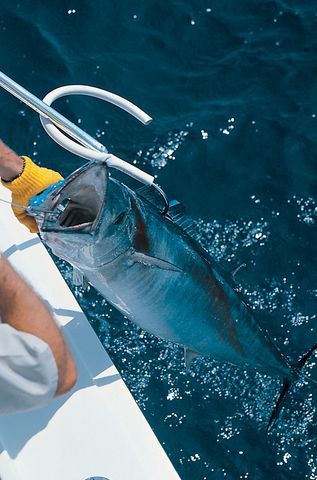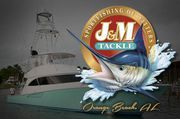
Early Summer Fishing on the Northern Gulf Coast
During the early month(s) of Summer, fishing can be a very productive time here on the Northern Gulf of Mexico. Whether you are targeting inshore species such as Speckled Trout, Redfish or Sheepshead; or offshore giants like Yellowfin Tuna, Wahoo or Blue Marlin. Some anglers would argue that this is their favorite time of year. Most fish that are commonly targeted by sportsmen, have been somewhat dormant over the Winter months and are now just starting to come to life and actively seek out food.
Two of the most targeted inshore species in our area during the late Spring and early Summer are the Sheepshead and Speckled Trout. Sheepshead, otherwise known as Convict Fish or Bait Stealers, spawn during the Spring. Usually, the warmer month before and after this event are very productive when fishing with live shrimp or Fiddler Crabs around any kind of structure such as rock jetties or pier pilings. The spawn almost always happens during the last full moon of March, granted, weather conditions permitting. It really is an amazing sight to see a huge school of these black and white striped fish rushing around each other releasing clouds of eggs into the water. Once the spawn is finished, much of the population head offshore into deeper water to live out the Summer and Winter months until it is time to start over again. Speckled trout spawn close to this time as well. These fish can be caught in most of the backwaters like coastal rivers, bays, canals and inlets. Again, live shrimp is the most common bait for Trout, but a lesser-known bait can be extremely productive during the spawning months. The common Atlantic Croaker is the sworn enemy of the Speckled Trout when it comes to their eggs. The Croaker actively seeks out and feeds on Trout eggs and fry. Naturally, the best way to eliminate this threat is to feed on it. A 2”-4” Croaker free lined or Carolina-rigged is a deadly bait from the end of March to the end of May. Fishing in Perdido Bay and Wolf Bay along the grass beds and banks can produce a 10-pound sow trout if you put in the time and effort.
Offshore fishing is really starting to heat up as well. The pelagic species come closer to shore as the water temperature starts rising. Spanish and King Mackerel are now very close to the beach and can be caught while trolling a planer and spoon or a duster rig within sight of land. Wahoo and Tuna come within reach as well. They tend to hang around in “blue water” mostly but will venture into dirtier water if their food supply is abundant there. Trolling for these fish is the most common method as well. For Wahoo, high speed lures work extremely well between 10 and 20 knots depending on the lure and boat. Ballyhoo pulled at slower speeds is a favorite for Yellowfin. Sometimes pulled “naked” or with a duster, Tuna can’t resist these guys and most anglers can’t resist the opportunity to catch a 150-pound bruiser.
These are just a few examples of what is available to anglers of all walks of life during these fair-weathered months. What’s most important is getting outdoors, enjoying what the water has to offer, and making memories with friends and family.
Written by Stephen Leach for J&M Tackle
About the Business
Have a question? Ask the experts!
Send your question

